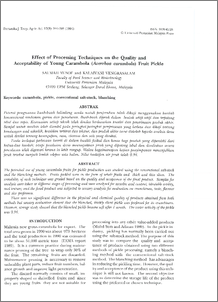Citation
Yusof, Salmah and Vengrasalam, Kalaivani
(1994)
Effect of Processing Techniques on the Quality and
Acceptability of Young Carambola (Averrhoa carambola) Fruit Pickle.
Pertanika Journal of Tropical Agricultural Science, 17 (3).
pp. 201-208.
ISSN 0126-6128
Abstract
The potential use of young carambola fruits for pickle production was studied using the conventional salt-stock
and the blanching methods. Fruits Pickled were in the form of whole fruits and thick and thin slices. The
suitability of each technique was graded based on the quality and acceptance of the final product. Samples for
analysis were taken at different stages of processing and were analysed for ascorbic acid content, titratable acidity,
and texture; and the final product was subjected to sensory analysis for evaluation on crunchiness, taste, flavour
and size preference.
There was no significant difference in the physical and chemical quality of products obtained from both
methods but sensory evaluation showed that the blanched, thickly sliced pickle was preferred for its crunchiness.
However, storage study showed that the blanched pickle became soft after 1 month. The water activity of the pickle
was 0.94.
Download File
![[img]](http://psasir.upm.edu.my/style/images/fileicons/application_pdf.png)  Preview |
|
PDF
Effect_of_Processing_Techniques_on_the_Quality_and.pdf
Download (4MB)
|
|
Additional Metadata
Actions (login required)
 |
View Item |

